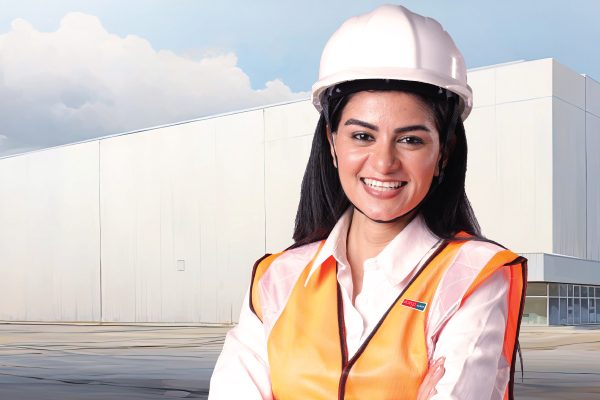The Indian logistics industry looks to be on the right path to achieve the goal of gender equality, but there is a lot more to achieve for a real impact than just increasing the women labour force participation rate.
“Society is not used to seeing us at certain places and in certain jobs,” 24-year-old Latha, manning a Shell fuelling station told me in the year 2015, when I asked her if she would ever drive a car or a truck.
When I gave it a thought, I couldn’t recall a single female truck or taxi driver I had seen during the 30 years of my existence because ‘we were not supposed to be in certain jobs’. However, these notions are changing, but slowly. In the year 2010, the female participation in India’s workforce was 23%, and it took our nation five years to achieve a 0.5% raise in this number, that is in 2015, when the female workforce participation reached 23.5%. However, the next five years saw an incredible shift, as we are currently looking at a 30.4% women labour force participation rate in 2020.
Numbers show increasing women participation
The logistics industry reiterates this growth, though not at the same pace, however, it shows a considerable increase in the women labour force participation rate. Globally, in 2010, women formed only 8% of the logistics workforce which has steadily increased to 20% in 2018. In India, specifically, this number currently stands at approximately 15% and is expected to reach the current global average of 20% by 2022.
Women made up 46.8% of the US labour force in 2015. However, of the 7.7 million workers in the US Transportation & Utilities sector, women constitute 22.6%.
According to the US Bureau of Labor Statistics, the trade, transportation, and utilities industry is the second largest employer of women, after manufacturing. In 2016, the industry employed 11.063 million women, registering a 3.9% increase from 2006.
The logistics sector can be a catalyst in hiring women
Despite a constant increase in the women labour force participation rate, the logistics industry needs much more in order to achieve the desired global average. The increase in numbers also include women who are hired for clerical jobs like accountants, administration, or roles like HR. When it comes to the senior management positions and top jobs the presence of women is still miniscule.
At the same time, the women to men ratio is increasing because of a sudden increase in jobs in the manufacturing and packaging sector, although some still find it surprising to see female workers in warehouses, transportation and delivery.
The low number of female managers is often blamed on lack of participation from female candidates, and ‘not receiving enough applications’ is the most common issue HRs face while screening for candidates for such positions.
According to a report, language of the advertisement plays a very crucial role. The importance of using gender-neutral language in the job descriptions can make a lot of difference. “We take great care to guide and advise our clients on using terms in job descriptions that are appropriate to both men and women. There are many pitfalls that companies can fall into if they are not careful in the way they phrase things. It’s easy to come across as patronising and women certainly don’t want to feel tokenised,” says the research analyst. An important aspect when finding a suitable candidate for a role is to also ensure that the CVs being submitted are gender agnostic.
Apart from this, it is important to make the work culture gender neutral as the number of women applying for blue-collared jobs is increasing. Introduction or implementation of policies like the 2017 Maternity Benefit Act, which increases the paid maternity leave to 26 weeks, and employers’ initiatives like subsidised childcare and flexible work hours also help women join the workforce. Among initiatives that could help, mandating a certain percentage share for women in the workforce for every firm could also help bridge the gender parity.
Change makers and trend setters
The number of women working in delivery companies has seen an almost 100% year-on-year growth. The credit of this growth can be given to the booming ecommerce sector with companies such as Amazon, Swiggy, HeyDee, and Even Cargo increasing their market share.
In 2016, India’s leading online marketplace, Amazon, had launched a first-of its-kind women-only delivery station in India. The first delivery station was setup in Thiruvananthapuram, Kerala, and the second in Chennai, Tamil Nadu. Through this initiative, Amazon took the lead in engaging with women, creating unique relevant job opportunities and enabling them to be achievers in this field.
Apart from these stations being completely run and managed by women, the women also deliver packages on two-wheelers, covering a radius of 2 to 3 km from their respective delivery stations. The company later on extended this service to Chandigarh and Dhule (Maharashtra) as well. However, later made the Thiruvananthapuram station open for male employees too.
Mumbai-based HeyDee has also made headlines with its exclusive women cargo delivery services. The company started in 2016 has already received two rounds of funding and has more than 300 delivery women.
The United Nations in its Global Goals for Sustainable Development also places emphasis on gender equality.
Here is what the SDG guidelines for logistics companies say to achieve gender equality:
- Design safe passenger transport solutions and practices that reduce women’s vulnerability to sexual violence and abuse whilst they are travelling.
- Engage in policy initiatives and partnership efforts that help to prevent and identify human trafficking and sexual exploitation which disproportionally affect women.
- Integrate the needs of women and girls into transportation and infrastructure policymaking and decision-making, both at company level and also informing government level policies and investments.
- Develop evidence-based strategies to attract and retain a higher proportion of female workers in the sector, considering organisational culture, health and safety and other issues.
- Increase the share of women on company Boards and in senior roles, and invest in policies and programmes which support the development of women in the workforce and encourage organisations in the value chain to do the same.
- Integrate the Women’s Empowerment Principles into core business operations and value chain to ensure a comprehensive approach to achieving gender equality, and encourage peers to do likewise.
If logistics companies are taking heed, we will see another jump in the percentage of women labour participation rate in the coming years.
About the author:
Akshara Sharma is a social scientist. She is a law graduate and an alumna of Tata Institute of Social Sciences. She has worked with foundations like Dish, Rural Litigation and Entitlement Kendra and Youth 4 Jobs Foundation.














